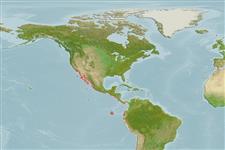>
Eupercaria/misc (Various families in series Eupercaria) >
Sciaenidae (Drums or croakers)
Etymology: Menticirrhus: Latin, mentum = beard, chin + Latin, cirrus = curly.
More on author: Girard.
Environment: milieu / climate zone / depth range / distribution range
Écologie
marin démersal; profondeur ? - 14 m (Ref. 9118). Subtropical; 37°N - 21°S, 123°W - 68°W
Eastern Pacific: California, USA to Peru.
Taille / Poids / Âge
Maturity: Lm ? range ? - ? cm
Max length : 71.0 cm TL mâle / non sexé; (Ref. 2850); poids max. publié: 3.9 kg (Ref. 2850); âge max. reporté: 8 années (Ref. 56049)
Occur along sandy shores and in bays, usually in sandy surfs of exposed outer coast. Usually found in small groups; larger fish are more solitary. Feed on sand crabs, other small crustaceans, and worms (Ref. 9118). Spawning begins in July (Ref. 9118). Pelagic spawners (Ref. 56049). Cannot produce croaking sounds due to lack of air bladder. Considered a good food fish and is common in markets (Ref. 9118).
Life cycle and mating behavior
Maturities | Reproduction | Spawnings | Egg(s) | Fecundities | Larves
Pelagic spawner (Ref. 56049).
Eschmeyer, W.N., E.S. Herald and H. Hammann, 1983. A field guide to Pacific coast fishes of North America. Boston (MA, USA): Houghton Mifflin Company. xii+336 p. (Ref. 2850)
Statut dans la liste rouge de l'IUCN (Ref. 130435)
Menace pour l'homme
Harmless
Utilisations par l'homme
Pêcheries: commercial; pêche sportive: oui
Outils
Articles particuliers
Télécharger en XML
Sources Internet
Estimates based on models
Preferred temperature (Ref.
123201): 17.8 - 28.9, mean 23.6 °C (based on 262 cells).
Phylogenetic diversity index (Ref.
82804): PD
50 = 0.5020 [Uniqueness, from 0.5 = low to 2.0 = high].
Bayesian length-weight: a=0.00933 (0.00531 - 0.01641), b=3.03 (2.88 - 3.18), in cm total length, based on LWR estimates for this species & (Sub)family-body (Ref.
93245).
Niveau trophique (Ref.
69278): 3.3 ±0.50 se; based on food items.
Generation time: 2.9 ( na - na) years. Estimated as median ln(3)/K based on 1
growth studies.
Résilience (Ref.
120179): Milieu, temps minimum de doublement de population : 1,4 à 4,4 années (tm=2.5; tmax=8).
Fishing Vulnerability (Ref.
59153): Low to moderate vulnerability (34 of 100).
